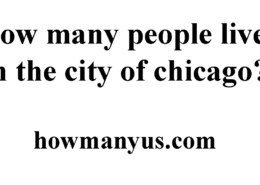How many people live in the city of chicago?
The question “How many people live in the city of Chicago?” seeks to understand the current population size of Chicago, one of the largest cities in the United States. Chicago is a major metropolitan area located in the state of Illinois, known for its diverse culture, vibrant neighborhoods, and iconic skyline.
As of the most recent data available, Chicago is estimated to have a population of over 2.7 million residents within the city limits. This makes Chicago the third-most populous city in the United States, behind New York City and Los Angeles.
The population of Chicago is diverse, with a mix of ethnicities, cultures, and socioeconomic backgrounds represented throughout the city. Chicago’s population density varies across its neighborhoods, from bustling downtown areas to quieter residential districts.
How many people live in the city of chicago?
Understanding the population of Chicago is essential for urban planning, resource allocation, and policy development. The city’s population size influences various aspects of daily life, including transportation infrastructure, public services, and economic opportunities.
Chicago’s population has seen fluctuations over the years due to factors such as migration, economic trends, and social changes. Demographic data provides valuable insights into the city’s dynamics and helps shape initiatives aimed at improving quality of life for residents.


The question “How many people live in the city of Chicago?” delves into the population size of one of the largest cities in the United States. Chicago, located in the state of Illinois, is a vibrant urban center known for its rich history, cultural diversity, and economic significance.
Population of Chicago:
As of the most recent estimates, Chicago has a population exceeding 2.7 million residents within its city limits. This places Chicago as the third-most populous city in the United States, following New York City and Los Angeles. The city’s population density varies across its neighborhoods, with downtown areas experiencing high levels of activity and residential districts offering quieter living environments.
Demographics of Chicago:
Chicago is renowned for its ethnic and cultural diversity, reflected in its demographics. The city is home to a mix of racial and ethnic groups, including African Americans, Hispanics, Caucasians, Asians, and others. This diversity contributes to Chicago’s dynamic cultural scene, culinary offerings, and community life.
Factors Influencing Population Size:
Several factors influence Chicago’s population size and growth patterns:
Importance of Population Data:
Accurate population data is crucial for urban planning, resource allocation, and policy development. City officials, researchers, and policymakers use demographic information to:
Historical Population Trends:
Chicago’s population has seen fluctuations over time. The city experienced significant growth during the late 19th and early 20th centuries, fueled by industrialization and immigration. In recent decades, Chicago has undergone demographic shifts, including suburbanization and gentrification in certain neighborhoods.
Future Population Projections:
Population projections provide insights into Chicago’s future growth and demographic composition. Forecasting population trends helps anticipate housing demands, workforce needs, and challenges related to aging populations.
Conclusion:
In conclusion, understanding the population of Chicago is essential for grasping the city’s dynamics, diversity, and development. With over 2.7 million residents, Chicago stands as a bustling urban hub with a rich tapestry of cultures and communities. Demographic data informs strategic decision-making and policy formulation to enhance quality of life, economic vitality, and social well-being for all residents of the Windy City.